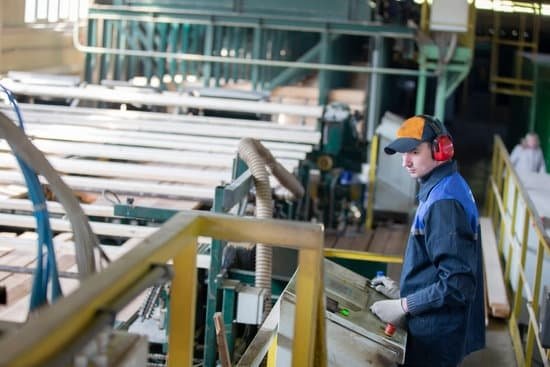Are you wondering how to prepare freshly cut wood for woodworking quickly? Properly preparing freshly cut wood is essential in ensuring the quality and longevity of your woodworking projects.
This article will guide you through the process of choosing the right type of wood, selecting the necessary tools and equipment, removing moisture from the wood, preparing the surface, and applying protective finishes. By understanding the importance of each step in the wood preparation process, you can enhance the overall quality of your woodworking projects.
When embarking on a woodworking project, choosing the right type of wood is crucial. The type of wood you choose will impact the overall look, durability, and ease of working with it. Additionally, having an understanding of the tools and equipment needed for the wood preparation process will ensure that you are properly equipped to tackle each step efficiently.
One important aspect of preparing freshly cut wood for woodworking is removing moisture from the wood. Excess moisture can lead to warping, cracking, and other issues that may affect the final outcome of your project. By learning how to effectively remove moisture from freshly cut wood, you can save time and ensure that your projects turn out as intended.
Choosing the Right Type of Wood for Your Project
When it comes to woodworking, the type of wood you choose for your project can greatly impact the outcome and longevity of your creation. Here are some things to consider when selecting the right type of wood for your woodworking project:
1. Consider the purpose of your project: Different types of wood have varying characteristics that make them suitable for specific purposes. For example, hardwoods like oak and maple are great for furniture-making due to their strength and durability, while softwoods like pine and cedar are more commonly used for outdoor projects like decks and fences.
2. Evaluate the appearance: The natural grain and color of the wood can add to the aesthetic appeal of your project. Consider whether you want a lighter or darker finish, as well as any unique patterns in the wood grain that may complement your design.
3. Factor in availability and cost: Some types of wood may be more readily available in your area or may be more cost-effective than others. It’s important to consider these practical aspects when choosing a type of wood for your project.
By taking these factors into account, you can ensure that you select the right type of wood that will not only meet the needs of your woodworking project but also enhance its overall visual appeal and durability.
Once you have chosen the appropriate type of wood for your project, you can then move on to preparing it for use in your woodworking endeavors. This process involves removing moisture from freshly cut wood, preparing its surface, and applying protective finishes in order to enhance its quality and longevity.
Tools and Equipment Needed for the Wood Preparation Process
Essential Tools for Wood Preparation
When it comes to preparing freshly cut wood for woodworking, having the right tools and equipment is crucial. Some essential tools include a moisture meter to measure the wood’s moisture content, a planer for smoothing and flattening the wood surfaces, and a jointer to create straight edges.
Other important tools include a table saw, chisels, sanders, and clamps. It’s also important to have safety equipment such as goggles, gloves, and a dust mask to protect yourself during the preparation process.
Additional Equipment for Wood Preparation
In addition to the basic tools needed for wood preparation, there are some additional pieces of equipment that can be beneficial. A kiln or dehumidifier can be used to speed up the drying process of freshly cut wood by removing excess moisture.
An air compressor paired with an air nozzle can help remove sawdust from hard-to-reach areas on the wood surface. Additionally, having a well-ventilated workspace and proper lighting is essential for carrying out the wood preparation process effectively.
Selecting High-Quality Tools and Equipment
When preparing freshly cut wood for woodworking, it’s important to invest in high-quality tools and equipment that will provide precise and accurate results. Ensure that your tools are sharp and well-maintained to achieve clean cuts and smooth surfaces on the wood.
When selecting equipment such as a moisture meter or dehumidifier, look for options that are reliable and provide accurate readings or performance. By using high-quality tools and equipment in the wood preparation process, you can ensure that your woodworking projects will meet professional standards.
By having the right tools and equipment on hand for preparing freshly cut wood for woodworking quickly, you can streamline the preparation process while achieving high-quality results.
Removing Moisture From the Freshly Cut Wood
When working with freshly cut wood, it’s crucial to remove excess moisture from the material to prevent warping, cracking, and other potential issues in your woodworking projects. The process of removing moisture from wood is known as “drying,” and there are several methods you can use to accomplish this quickly.
One of the most common and efficient ways to dry freshly cut wood is through kiln drying. This method involves placing the wood in a controlled environment with low humidity and high temperature to accelerate the evaporation of moisture. Kiln drying can take anywhere from a few days to a few weeks, depending on the type and thickness of the wood.
For DIY enthusiasts or those without access to a kiln, air-drying is another effective method for removing moisture from freshly cut wood. This method requires stacking and storing the wood in a well-ventilated area with good airflow, such as a covered outdoor space. Air-drying can take several months to achieve the desired level of moisture content in the wood, but it’s a cost-effective option for those willing to invest the time.
Another alternative for quickly removing moisture from freshly cut wood is using desiccants or moisture-absorbing materials such as sawdust or cat litter. These materials can help draw out excess moisture from the wood at a faster rate than air-drying alone. Additionally, using a dehumidifier in an enclosed space where the wood is stored can also speed up the drying process significantly.
| Wood Drying Method | Time Required |
|---|---|
| Kiln Drying | A few days to a few weeks |
| Air-Drying | Several months |
| Desiccants/Moisture-Absorbing Materials | Faster than air-drying alone |
Preparing the Surface of the Wood for Woodworking
Wood preparation for woodworking involves more than just removing excess moisture and applying protective finishes. It is equally important to prepare the surface of the wood before beginning any woodworking project. This step ensures that the wood is smooth, even, and free from imperfections, allowing for precise and professional-looking results.
Sanding the Wood
One of the most crucial steps in preparing the surface of freshly cut wood for woodworking is sanding. Sanding helps to remove any rough spots, uneven surfaces, or tool marks from the wood. Start with a coarse-grit sandpaper to remove any prominent imperfections, then gradually work your way up to finer grits for a smoother finish. Be sure to sand with the grain of the wood to avoid creating scratches or damage.
Filling in Gaps and Knots
Freshly cut wood often contains gaps, knotholes, or other imperfections that can interfere with woodworking projects. Before moving on to cutting or shaping the wood, use a suitable wood filler to fill in these imperfections. Allow the filler to dry completely before sanding it down to create a seamless surface.
Sealing and Priming
Once the wood surface is smooth and even, it’s essential to seal and prime it before proceeding with any woodworking tasks. This not only prepares the wood for receiving stains or paints but also helps to protect it from moisture and other environmental factors. Apply a suitable wood sealer or primer according to the manufacturer’s instructions for best results.
By following these steps in preparing freshly cut wood for woodworking quickly while minimizing errors or complications during your project.
Applying Protective Finishes to the Prepared Wood
Once the freshly cut wood has been properly dried and the surface has been prepared for woodworking, it’s important to apply protective finishes to ensure the longevity and durability of your woodworking project. There are different types of protective finishes available, including varnishes, lacquers, and oils, each with its unique properties and application methods.
One popular option is using polyurethane varnish, which provides a hard and durable finish that can withstand heavy use, making it ideal for furniture and other high-traffic items. Another common choice is using mineral oil or tung oil for a more natural look, especially for wooden utensils and cutting boards. It’s important to consider the specific needs of your woodworking project when choosing a protective finish.
When applying protective finishes to wood, it’s essential to follow the manufacturer’s instructions carefully for the best results. This typically involves using a brush or rag to apply an even coat of the finish, allowing it to dry completely between coats, and sanding lightly between each coat to achieve a smooth and flawless finish.
Protective finishes not only enhance the appearance of wood but also provide resistance against moisture, heat, and scratches. By choosing the right protective finish and applying it correctly, you can ensure that your woodworking project will stand the test of time.
| Protective Finish | Ideal Use |
|---|---|
| Polyurethane varnish | Furniture and high-traffic items |
| Mineral oil or tung oil | Wooden utensils and cutting boards |
| Lacquer | Fine furniture |
Tips for Speeding Up the Wood Preparation Process
When it comes to woodworking, properly preparing freshly cut wood is crucial for the success of your projects. It ensures that the wood is free from moisture, has a smooth surface, and is ready to be transformed into beautiful pieces.
While the traditional method of air-drying wood can take months, there are ways to speed up the wood preparation process without compromising quality. Here are some tips for accelerating the preparation of freshly cut wood for woodworking quickly:
- Use a moisture meter to accurately measure the moisture content of the wood. This will help you determine when the wood has reached the optimal level of dryness for woodworking.
- Invest in a kiln or build your own solar kiln to rapidly remove moisture from the freshly cut wood. Kiln-drying can significantly reduce the drying time compared to air-drying, allowing you to prepare the wood for your project much faster.
- Consider using a dehumidification system in conjunction with a fan to accelerate the drying process. This method can be especially useful in humid environments where air-drying may be less effective.
By implementing these tips, you can effectively reduce the time it takes to prepare freshly cut wood for woodworking without sacrificing quality. Whether you are working on a DIY project or a professional woodworking endeavor, utilizing these methods will allow you to expedite the preparation process and bring your vision to life sooner.
It’s important to note that while speeding up the wood preparation process is beneficial, it’s essential to ensure that the wood is adequately dried and prepared before beginning any woodworking project. Rushing through this stage could lead to issues such as warping, cracking, or other structural problems in your final pieces. With proper care and attention, you can efficiently and effectively prepare freshly cut wood for all your woodworking projects.
Conclusion
In conclusion, properly preparing freshly cut wood for woodworking is crucial in ensuring the success and quality of your projects. Choosing the right type of wood for your project is essential, as different woods have different characteristics and properties that can affect the outcome of your woodworking. Additionally, having the appropriate tools and equipment for the wood preparation process will make the task more efficient and effective.
One of the key steps in preparing freshly cut wood for woodworking is removing moisture from the wood. This can be done through air drying or kiln drying, depending on the type of wood and the specific requirements of your project. Once the moisture has been removed, it is important to properly prepare the surface of the wood for woodworking by sanding, planing, or shaping as needed.
Applying protective finishes to the prepared wood can enhance its durability and appearance, making it a worthwhile investment in prolonging the life of your woodworking projects. To speed up the wood preparation process, consider using techniques such as steam bending or chemical treatments to expedite the drying and conditioning of the wood.
By taking these steps to prepare freshly cut wood for woodworking quickly and efficiently, you can ensure that your projects are not only beautiful but also durable and long-lasting.
Frequently Asked Questions
How Long Should Wood Dry Before Woodworking?
Wood should ideally dry for at least six months before woodworking. This allows the wood to reach a moisture content that is suitable for working without risking warping or cracking. However, some hardwoods might require longer drying times.
How Do You Dry Out Fresh Cut Wood Fast?
To dry out fresh cut wood fast, you can use a kiln or a dehumidifier to speed up the drying process. Another method is to seal the ends of the wood with wax or paint to slow down moisture loss and prevent checking and splitting.
It’s important to monitor the moisture content during this process to ensure the wood dries evenly.
How Long Before You Can Use Fresh Cut Wood?
The time before you can use fresh cut wood depends on several factors such as the type of wood, its thickness, and the drying method used. In general, softwoods may be ready for use in about three to six months, while hardwoods might take a year or more.
It’s critical to let the wood acclimate to your workshop environment for several weeks before starting any woodworking projects.

Hi everyone! I’m a woodworker and blogger, and this is my woodworking blog. In my blog, I share tips and tricks for woodworkers of all skill levels, as well as project ideas that you can try yourself.





